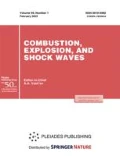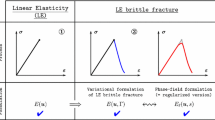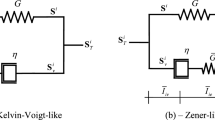Abstract
Investigations of specific features of the microstructure of the region where a spall crack transforms to an adiabatic shear band are based on a spall model of strain localization, which implies that adiabatic shear bands are induced by interference of unloading waves, and the value of the negative stress in the expansion region of these waves does not exceed the dynamic strength of the material. It is shown that the transformation region contains a tremendous number of dislocation ensembles, which is much greater than the number of dislocation ensembles generated by a shock wave. Detection of micrometer-sized fracture sites in the region of interference of unloading waves implies that small fracture sites are formed in a polycrystalline material on dislocations arising in the course of dynamic tension.
Similar content being viewed by others
References
R. L. Woodward, “The Penetration of Metal Targets which Fail by Adiabatic Shear Plugging,” Int. J. Mech. Sci. 20, 599–607 (1978).
T. W. Wright, The Physics and Mathematics of Adiabatic Shear Bands (University Press, Cambridge, 2002).
M. N. Raftenberg, “A Shear Banding Model for Penetration Calculation,” Report No. ARL-TR-2221 (U. S. Army Research Laboratory, 2000).
T. A. C. Stock and K. R. L. Thomson, “Penetration of Aluminum Alloys by Projectiles,” Metallurg. Trans. 1, 219–224 (1970).
M. Hammerschmidt and H. Kreye, “The Role of Adiabatic Shearing in Explosive Welding,” in Shock Wave and High Strain Rate Phenomena in Metals, Ed. by M. A. Meyers and L. E. Murr (Plenum Press, New York, 1981), pp. 187–197.
G. L. Moss, “Shear Strains, Strain Rates and Temperature Changes in Adiabatic Shear Bands,” in Shock Wave and High Strain Rate Phenomena in Metals, Ed. by M. A. Meyers and L. E. Murr (Plenum Press, New York, 1981), pp. 30–40.
H. C. Rogers and C. V. Shastry, “Structural Changes in Steels at Adiabatic Shear,” in Shock Wave and High Strain Rate Phenomena in Metals, Ed. by M. A. Meyers and L. E. Murr (Plenum Press, New York, 1981), pp. 301–309.
S. P. Timothy and I. M. Hutchings, “The Structure of Adiabatic Shear Bands in a Titanium Alloy,” Acta Metallurg. 33, 667–676 (1985).
D. E. Grady and J. R. Asay, “Calculation of Thermal Trapping in Shock Deformation of Aluminum,” J. Appl. Phys. 53 (11), 7350–7354 (1982).
M. A. Meyers, Yb. Xu, Q. Xue, et al., “Microstructural Evolution in Adiabatic Shear Localization in Stainless Steel,” Acta Materialia 51, 1207–1325 (2003).
A. F. Belikova, S. N. Buravova, and Yu. A. Gordopolov, “Strain Localization and its Relationship with the Strain State of the Material,” Zh. Tekh. Fiz. 58 (2), 153–156 (2013).
A. F. Belikova, S. N. Buravova, and E. V. Petrov, “Strain Localization under Dynamic Loading,” Zh. Tekh. Fiz. 58 (8), 68–75 (2013).
H. A. Grebe, H.-R. Pak, and M. A. Meyers, “Adiabatic Shear Localization in Titanium and Ti-Alloy,” Metallurg. Trans. A 16, 761–775 (1985).
C. L.Wittman, M. A. Meyers, and H.-R. Pak, “Observation of an Adiabatic Shear Band in AlSi 4340 Steel by High-Voltage Transmission Electron Microscopy,” Metallurg. Trans. A 21, 707–716 (1990).
D. Rittel and S. Osovski, “Dynamic Failure by Adiabatic Shear Banding,” Int. J. Fracture, No. 162, 177–185 (2010).
G. I. Kanel, S. I. Razorenov, A. V. Utkin, and V. E. Fortov, Shock-Wave Phenomena in Condensed Media (Yanus-K, Moscow, 1996) [in Russian].
S. A. Atroshenko and D. M. Olenin, “Local Shear Rate in the Spall Region,” Fiz. Met. Metalloved. 87 (2), 90–96 (1999).
A. V. Dobromyslov, N. I. Taluts, E. A. Kozlov, et al., “Specific Features of High-Rate Plastic Straining of Polycrystalline Copper Loaded by Spherically Converging Shock Waves of Different Intensities,” in Abstracts of the XVth Khariton’s Topical Scientific Readings (Sarov, 2013), p. 195.
M. A. Mogilevskii, V. V. Bulgakov, and A. D. Kormachev, “Deformation of Armco Iron and Copper at Strain Rates of 104–105 s-1,” Fiz. Goreniya Vzryva 30 (3), 96–100 (1994) [Combust., Expl., Shock Waves 30 (3), 350–353 (1994)].
U. Andrade, M. A. Meyers, K. S. Vecchio, and A. H. Chokshi, “Dynamic Recrystallization in High-Strain, High-Strain-Rate Plastic Deformation of Copper,” Acta Metallurg. Mater. 42 (9), 3183–3195 (1994).
O. N. Ignatova, I. I. Kaganova, A. N. Malyshev, et al., “Effect of Shock-Wave Loading on the Internal Microstructure and Mechanical Properties of Fine-Grained Copper,” Fiz. Goreniya Vzryva 46 (6), 119–124 (2010) [Combust., Expl., Shock Waves 46 (6), 719–723 (2010)].
S. V. Razorenov and G. I. Kanel, “Strength of Copper Single Crystals and Determining Factors of Fracture of Metals under Uniaxial Dynamic Tension,” Fiz. Met. Metallogr., No. 11, 141–147 (1992).
V. I. Betekhtin and A. G. Kadomtsev, “Evolution of Microscopic Cracks and Pores in Loaded Solids,” Fiz. Tverd. Tela 47 (5), 801–807 (2005).
V. F. Nesterenko and M. P. Bondar’, “Localization of Deformation in Collapse of a Thick Walled Cylinder,” Fiz. Goreniya Vzryva 30 (4), 99–111 (1994) [Combust., Expl., Shock Waves 30 (4), 500–509 (1994)].
M. A. Meyers and L. E. Murr, “The Formation of Defects in the Shock Wave Deformation,” in Shock Waves and High-Strain-Rate Phenomena in Metals, Ed. by M. A. Meyers and L. E. Murr (Plenum Press, New York, 1981).
V. A. Ogorodnikov, A. A. Sadovoi, V. N. Sofronov, et al., “Kinetic Model of Plastic Fracture with Allowance for Dissipative Processes,” Khim. Fiz. 21 (9), 104–109 (2002).
N.-Y. Tang, P. Niessen, R. J. Pick, and M. J. Worswick, “An Investigation of Shock-Induced Damage in Oxygen-Free High Conductivity Copper,” Mater. Sci. Eng. A 131, 153–161 (1991).
Author information
Authors and Affiliations
Corresponding author
Additional information
Original Russian Text © S.N. Buravova, E.V. Petrov, A.S. Shchukin.
Published in Fizika Goreniya i Vzryva, Vol. 52, No. 5, pp. 131–140, September–October, 2016.
Rights and permissions
About this article
Cite this article
Buravova, S.N., Petrov, E.V. & Shchukin, A.S. Specific features of the transformation of spall cracks to localized shear bands. Combust Explos Shock Waves 52, 613–620 (2016). https://doi.org/10.1134/S0010508216050129
Received:
Published:
Issue Date:
DOI: https://doi.org/10.1134/S0010508216050129




